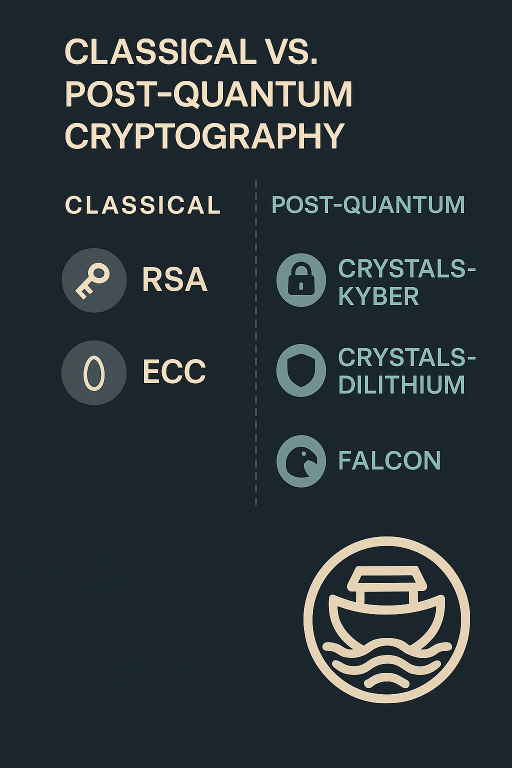The internet as we know it relies on cryptography—quietly, constantly, and completely. Whether it’s messaging apps, banking systems, VPNs, or email, encryption is what keeps our data private and our communications secure. But in the not-too-distant future, quantum computing may break many of the cryptographic assumptions that currently hold the web together. At SealedWeb, we’re watching this shift closely. In this post, we’ll explain:
-
What quantum computing threatens
-
Which cryptographic systems are at risk
-
What we’re planning to do to mitigate or eliminate these risks before they become real-world threats
How Quantum Computing Breaks the Web’s Security Model
Today’s internet security relies on problems that are computationally hard for classical computers. Examples:
-
RSA, based on the difficulty of factoring large numbers
-
Elliptic Curve Cryptography (ECC), based on discrete logarithm problems
-
Diffie-Hellman key exchange, based on similar assumptions
These are hard problems—but only for classical machines. Quantum computers, once mature enough, could use algorithms like:
-
Shor’s Algorithm — breaks RSA and ECC by factoring and solving discrete logs efficiently
-
Grover’s Algorithm — speeds up brute force attacks on symmetric encryption
The implications are huge. Consider these:
-
Encrypted traffic could be decrypted retroactively
-
Private keys could be stolen
-
Secure communications could be compromised—even ones recorded today
What This Means for Everyone
Even though large-scale quantum computers don’t exist yet, attackers could record encrypted traffic today and decrypt it later—a threat known as Harvest Now, Decrypt Later. For companies handling medical records, sensitive legal data, or state secrets, this is more than theoretical. And for platforms like SealedWeb that prioritize long-term privacy, it’s a call to prepare now.
What SealedWeb Is Planning to Do
At SealedWeb, we believe cryptographic agility must be built into the platform from the start. Here’s how we plan to handle quantum risk:
1. Cryptographic Agility
We’re designing our systems to allow easy substitution of cryptographic primitives. This means we can:
-
Switch from ECC to post-quantum algorithms when needed
-
Phase out legacy algorithms without disrupting user access
-
Support hybrid cryptography during transition phases
Agility ensures we’re not locked into vulnerable structures.
2. Adopting Post-Quantum Cryptography (PQC)
We are actively evaluating post-quantum algorithms under review by NIST (U.S. National Institute of Standards and Technology), including:
-
CRYSTALS-Kyber (key encapsulation)
-
CRYSTALS-Dilithium (digital signatures)
-
FALCON and SPHINCS+ (alternative signature schemes)
Once standards are finalized, SealedWeb will:
-
Begin integrating PQC into user identity and session negotiation
-
Support hybrid encryption (classical + PQ) to maintain compatibility and redundancy
3. Quantum-Resistant Messaging & Storage
For our encrypted communications:
-
Future-proof key exchange with PQC-based algorithms
-
Ensure stored encrypted messages are protected from future decryption by using forward secrecy + quantum-hardened encryption
-
Build in expiration and re-keying mechanisms to phase out classical keys gracefully
4. Resisting “Harvest Now, Decrypt Later” Attacks
Even before quantum machines arrive, we are:
-
Limiting metadata and minimizing long-term data exposure
-
Using ephemeral keys and key rotation
-
Avoiding persistent identity-to-data links unless absolutely required
SealedWeb will also offer quantum-safe vaults—encryption layers for long-lived documents or records that need post-quantum protection today, not “someday.”
The Path Ahead
Quantum computing isn’t a threat to panic over—but it is a threat to prepare for. Much like Y2K, the danger lies not in the hype, but in the assumptions we’ve silently built systems on. At SealedWeb, we believe:
Privacy should last longer than today’s math.
That’s why we’re building an infrastructure that will evolve with the threat landscape—without compromising usability or trust.
Final Thoughts
Quantum computing could be the single greatest disruption to internet security in decades. But with foresight, architectural flexibility, and cryptographic discipline, we don’t have to be caught off guard. SealedWeb is readying for that future—so our users won’t have to.








